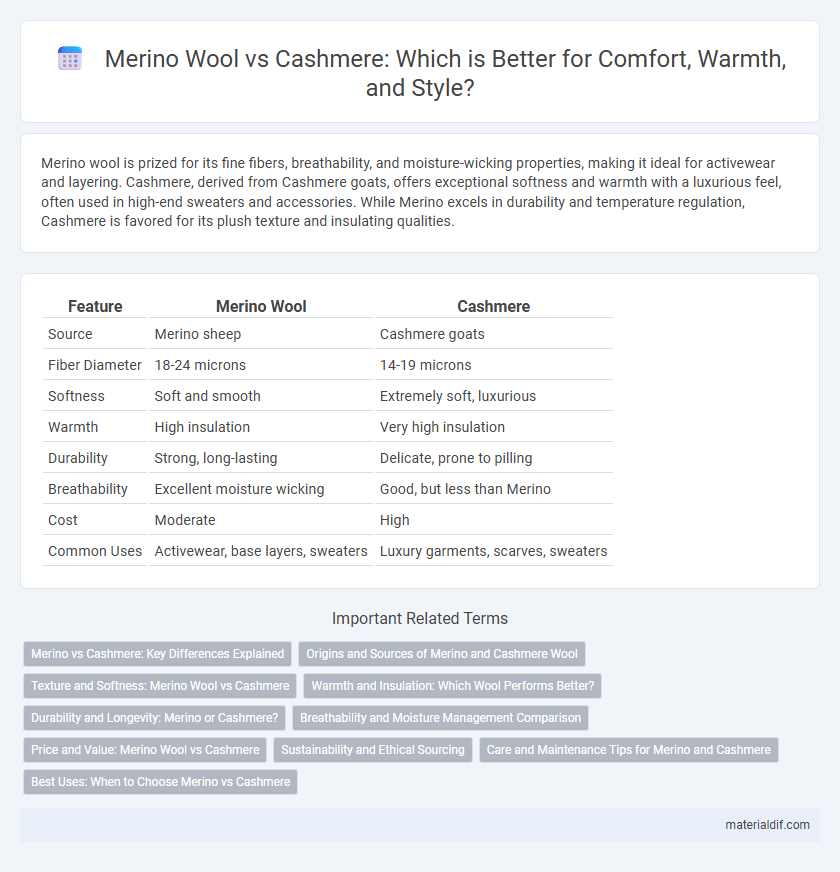Merino wool is prized for its fine fibers, breathability, and moisture-wicking properties, making it ideal for activewear and layering. Cashmere, derived from Cashmere goats, offers exceptional softness and warmth with a luxurious feel, often used in high-end sweaters and accessories. While Merino excels in durability and temperature regulation, Cashmere is favored for its plush texture and insulating qualities.
Table of Comparison
| Feature | Merino Wool | Cashmere |
|---|---|---|
| Source | Merino sheep | Cashmere goats |
| Fiber Diameter | 18-24 microns | 14-19 microns |
| Softness | Soft and smooth | Extremely soft, luxurious |
| Warmth | High insulation | Very high insulation |
| Durability | Strong, long-lasting | Delicate, prone to pilling |
| Breathability | Excellent moisture wicking | Good, but less than Merino |
| Cost | Moderate | High |
| Common Uses | Activewear, base layers, sweaters | Luxury garments, scarves, sweaters |
Merino vs Cashmere: Key Differences Explained
Merino wool, sourced from Merino sheep primarily in Australia and New Zealand, is renowned for its fine fibers, breathability, and moisture-wicking properties, making it ideal for activewear and outdoor clothing. Cashmere, harvested from the undercoat of Cashmere goats mainly in Mongolia and China, is prized for its exceptional softness, luxury feel, and superior insulation, often used in high-end sweaters and scarves. While Merino excels in durability and temperature regulation, Cashmere offers unmatched softness and warmth, highlighting key differences in fiber origin, texture, and typical applications.
Origins and Sources of Merino and Cashmere Wool
Merino wool originates from the Merino sheep primarily bred in Spain, Australia, and New Zealand, known for its fine, soft fibers ideal for high-performance clothing. Cashmere wool is sourced from the undercoat of Cashmere goats native to regions in Mongolia, China, and Iran, prized for its exceptional warmth and luxurious softness. The distinct geographical origins contribute to the unique fiber structures and qualities that differentiate Merino and Cashmere in the textile industry.
Texture and Softness: Merino Wool vs Cashmere
Merino wool offers a fine, smooth texture with exceptional breathability and moisture-wicking properties, making it ideal for active wear. Cashmere is renowned for its ultra-soft, luxurious feel, derived from the fine undercoat of cashmere goats, providing superior warmth and a silky touch. While Merino balances softness with durability, Cashmere excels in plush comfort and delicate softness.
Warmth and Insulation: Which Wool Performs Better?
Merino wool offers superior moisture-wicking properties and excellent breathability, providing consistent warmth without overheating, ideal for active wear in cooler climates. Cashmere, derived from the soft undercoat of goats, excels in insulation due to its fine fibers that trap heat efficiently, making it warmer but less moisture-resistant than Merino. For optimal warmth and insulation, Cashmere outperforms Merino in colder, dry conditions, while Merino is better suited for versatile temperature regulation and moisture management.
Durability and Longevity: Merino or Cashmere?
Merino wool offers superior durability and resistance to wear compared to cashmere, making it ideal for everyday apparel and activewear. Cashmere, while luxuriously soft, is more prone to pilling and fiber breakage, which can reduce its longevity under frequent use. Choosing Merino wool ensures extended garment life and consistent performance in various conditions.
Breathability and Moisture Management Comparison
Merino wool excels in breathability due to its fine fibers that allow for superior air circulation, while cashmere offers moderate breathability with a denser fiber structure. In moisture management, Merino efficiently wicks sweat away from the skin, promoting quick drying and temperature regulation, whereas cashmere retains more moisture, which can lead to slower drying times. These differences make Merino wool more suitable for active wear requiring enhanced ventilation and moisture control compared to the luxurious but less breathable cashmere.
Price and Value: Merino Wool vs Cashmere
Merino wool typically offers a more affordable price point compared to cashmere, making it a popular choice for high-quality yet budget-conscious consumers. Cashmere commands a premium price due to its rarity, softness, and insulation properties, translating into greater value for luxury apparel and accessories. Evaluating cost versus long-term wear, Merino wool provides durable performance and moisture-wicking benefits, while cashmere delivers unparalleled softness and warmth, influencing consumer decisions based on desired quality and investment.
Sustainability and Ethical Sourcing
Merino wool, sourced primarily from sheep in Australia and New Zealand, is often praised for its sustainable attributes due to the animals' ability to graze on natural pastures with minimal environmental disruption and the breed's efficient fleece regrowth. Cashmere, derived from the undercoat of Cashmere goats mainly found in Mongolia and China, faces sustainability challenges linked to overgrazing and land degradation, prompting increased efforts for ethical sourcing and sustainable herd management. Both fibers benefit from certifications like Responsible Wool Standard (RWS) for Merino and Sustainable Fibre Alliance (SFA) for Cashmere, which promote animal welfare and environmentally responsible farming practices.
Care and Maintenance Tips for Merino and Cashmere
Merino wool requires gentle hand washing in cold water with a wool-specific detergent to maintain its softness and elasticity, while avoiding wringing or hanging to prevent stretching. Cashmere demands even more delicate care, best cleaned through dry cleaning or gentle hand washing using lukewarm water and a mild detergent, with flat drying to preserve its luxurious texture. Both fibers benefit from proper storage in breathable bags and periodic airing to prevent moth damage and maintain fiber longevity.
Best Uses: When to Choose Merino vs Cashmere
Merino wool excels in activewear and layering garments due to its moisture-wicking properties, breathability, and temperature regulation, making it ideal for outdoor activities and sports. Cashmere offers superior softness and insulation, best suited for luxury sweaters, scarves, and cold-weather accessories where warmth and comfort are prioritized. Choosing Merino is optimal for performance-focused clothing, while Cashmere is preferred for high-end, cozy fashion pieces.
Merino vs Cashmere Infographic

 materialdif.com
materialdif.com